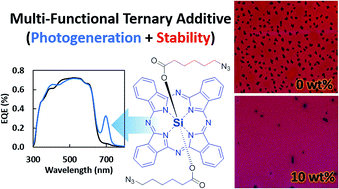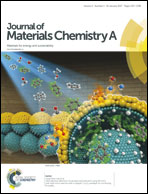Multifunctional ternary additive in bulk heterojunction OPV: increased device performance and stability†
Abstract
Great improvements in the development of organic photovoltaic (OPV) devices have been reported over the years; however, the overall efficiency and operational lifetimes of the devices must be improved. Maintaining a stable power conversion efficiency (PCE) in bulk heterojunction OPV devices can be achieved by utilizing cross-linkable ternary additives that freeze the optimal morphology. However, these additives currently do not contribute to improving the PCE of the device therefore limiting their overall effectiveness. In this study we present a dual functional bis(6-azidohexanoate)silicon phthalocyanine ((HxN3)2-SiPc) with cross-linking groups and near IR absorption as a ternary additive in poly(3-hexylthiophene) (P3HT) and phenyl-C61-butyric acid methyl ester (PC61BM) devices. As an additive at 10 wt% with respect to PC61BM, (HxN3)2-SiPc increased the short circuit current density (Jsc) by ≈9% due to increased photocurrent generation in the near IR region. In addition, devices utilizing (HxN3)2-SiPc exhibited a 97% PCE retention after thermal ageing at 150 °C for 23 h (compared to 47% retention for baseline devices) showing the compound is an effective cross-linker. These findings represent the first example of a multifunctional dye additive in an OPV device that simultaneously broadens the spectral coverage, resulting in added photogeneration, and stabilizes the active layer morphology, resulting in increased PCE retention.



 Please wait while we load your content...
Please wait while we load your content...